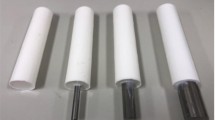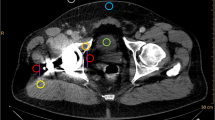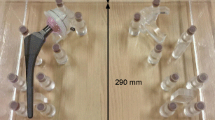Abstract
Purpose
The aim of this study was to determine whether high keV monoenergetic reconstruction of dual energy computed tomography (DECT) could be used to overcome the effects of beam hardening artefact that arise from preferential deflection of low energy photons.
Materials and Methods
Two phantoms were used: a Charnley total hip replacement set in gelatine and a Catphan 500. DECT datasets were acquired at 100, 200 and 400 mA (Siemens Definition Flash, 100 and 140 kVp) and reconstructed using a standard combined algorithm (1:1) and then as monoenergetic reconstructions at 10 keV intervals from 40 to 190 keV. Semi-automated segmentation with threshold inpainting was used to obtain the attenuation values and standard deviation (SD) of the streak artefact. High contrast line pair resolution and background noise were assessed using the Catphan 500.
Results
Streak artefact is progressively reduced with increasing keV monoenergetic reconstructions. Reconstruction of a 400 mA acquisition at 150 keV results in reduction in the volume of streak artefact from 65 cm3 to 17 cm3 (74 %). There was a decrease in the contrast to noise ratio (CNR) at higher tube voltages, with the peak CNR seen at 70–80 keV. High contrast spatial resolution was maintained at high keV values.
Conclusion
Monoenergetic reconstruction of dual energy CT at increasing theoretical kilovoltages reduces the streak artefact produced by beam hardening from orthopaedic prostheses, accompanied by a modest increase in heterogeneity of background image attenuation, and decrease in contrast to noise ratio, but no deterioration in high contrast line pair resolution.







Similar content being viewed by others
References
Fayad LM, Patra A, Fishman EK. Value of 3D CT in defining skeletal complications of orthopedic hardware in the postoperative patient. AJR Am J Roentgenol. 2009;193(4):1155–63.
Buckwalter KA, Rydberg J, Kopecky KK, Crow K, Yang EL. Musculoskeletal imaging with multislice CT. AJR Am J Roentgenol. 2001;176(4):979–86.
Barrett JF, Keat N. Artifacts in CT: recognition and avoidance. Radiographics. 2004;24(6):1679–91.
Moon SG, Hong SH, Choi J-Y, Jun WS, Kang H-G, Kim H-S, et al. Metal artifact reduction by the alteration of technical factors in multidetector computed tomography: a 3-dimensional quantitative assessment. J Comput Assist Tomogr. 2008;32(4):630–3.
Perrella A, Lopes PML, Rocha RG, Fenyo-Pereira M, Cavalcanti MGP. Influence of dental metallic artifact from multislice CT in the assessment of simulated mandibular lesions. J Appl Oral Sci. 2010;18(2):149–54.
Vande Berg B, Malghem J, Maldague B, Lecouvet F. Multi-detector CT imaging in the postoperative orthopedic patient with metal hardware. Eur J Radiol. 2006;60(3):470–9.
Link TM, Berning W, Scherf S, Joosten U, Joist A, Engelke K, et al. CT of metal implants: reduction of artifacts using an extended CT scale technique. J Comput Assist Tomogr. 2000;24(1):165–72.
Fishman EK, Magid D, Robertson DD, Brooker AF, Weiss P, Siegelman SS. Metallic hip implants: CT with multiplanar reconstruction. Radiology. 1986;160(3):675–81.
Stradiotti P, Curti A, Castellazzi G, Zerbi A. Metal-related artifacts in instrumented spine. Techniques for reducing artifacts in CT and MRI: state of the art. Eur Spine J. 2009;18 Suppl 1:102–8.
Kalender WA, Hebel R, Ebersberger J. Reduction of CT artifacts caused by metallic implants. Radiology. 1987;164(2):576–7.
Mahnken AH, Raupach R, Wildberger JE, Jung B, Heussen N, Flohr TG, et al. A new algorithm for metal artifact reduction in computed tomography: in vitro and in vivo evaluation after total hip replacement. Invest Radiol. 2003;38(12):769–75.
De Cecco CN, Buffa V, Fedeli S, Luzietti M, Vallone A, Ruopoli R, et al. Dual energy CT (DECT) of the liver: conventional versus virtual unenhanced images. Eur Radiol. 2010;20(12):2870–5.
Graser A, Johnson TRC, Chandarana H, Macari M. Dual energy CT: preliminary observations and potential clinical applications in the abdomen. Eur Radiol. 2009;19(1):13–23.
Brown CL, Hartman RP, Dzyubak OP, Takahashi N, Kawashima A, McCollough CH, et al. Dual-energy CT iodine overlay technique for characterization of renal masses as cyst or solid: a phantom feasibility study. Eur Radiol. 2009;19(5):1289–95.
Droege RT, Morin RL. A practical method to measure the MTF of CT scanners. Med Phys. 1982;9(5):758–60.
Verdun FR, Denys A, Valley J-F, Schnyder P, Meuli RA. Detection of Low-Contrast Objects: Experimental Comparison of Single– and Multi–Detector Row CT with a Phantom1. Radiology. 2002;223(2):426–31.
Gupta AK, Nelson RC, Johnson GA, Paulson EK, Delong DM, Yoshizumi TT. Optimization of Eight-Element Multi–Detector Row Helical CT Technology for Evaluation of the Abdomen1. Radiology. 2003;227(3):739–45.
Farr RF, Allisy-Roberts PJ. Physics for medical imaging. London: Saunders; 2000.
Wang G, Frei T, Vannier MW. Fast iterative algorithm for metal artifact reduction in X-ray CT. Acad Radiol. 2000;7(8):607–14.
Lee M-J, Kim S, Lee S-A, Song H-T, Huh Y-M, Kim D-H, et al. Overcoming artifacts from metallic orthopedic implants at high-field-strength MR imaging and multi-detector CT. Radiographics. 2007;27(3):791–803.
Robertson DD, Weiss PJ, Fishman EK, Magid D, Walker PS. Evaluation of CT techniques for reducing artifacts in the presence of metallic orthopedic implants. J Comput Assist Tomogr. 1988;12(2):236–41.
Bamberg F, Dierks A, Nikolaou K, Reiser MF, Becker CR, Johnson TRC. Metal artifact reduction by dual energy computed tomography using monoenergetic extrapolation. Eur Radiol. 2011;21(7):1424–9.
Funding
None.
Conflict of Interests
None.
Ethical approval
None required.
Author information
Authors and Affiliations
Corresponding author
Rights and permissions
About this article
Cite this article
Lewis, M., Reid, K. & Toms, A.P. Reducing the effects of metal artefact using high keV monoenergetic reconstruction of dual energy CT (DECT) in hip replacements. Skeletal Radiol 42, 275–282 (2013). https://doi.org/10.1007/s00256-012-1458-6
Received:
Revised:
Accepted:
Published:
Issue Date:
DOI: https://doi.org/10.1007/s00256-012-1458-6




